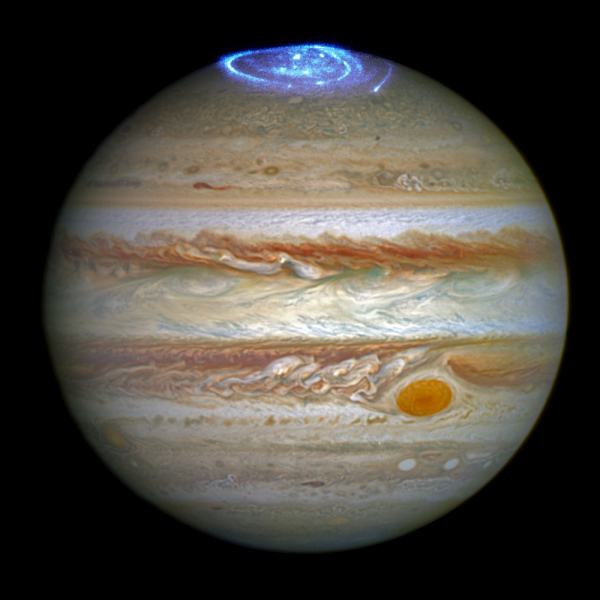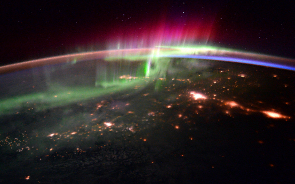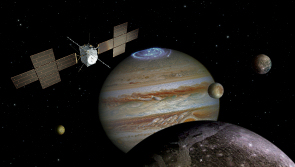Surprisingly erratic X-ray auroras discovered at Jupiter
30 October 2017
ESA and NASA space telescopes have revealed that, unlike Earth's polar lights, the intense auroras seen at Jupiter's poles unexpectedly behave independently of one another. |
| Hubble images vivid ultraviolet auroras at Jupiter. Credit: NASA, ESA, and J. Nichols (University of Leicester) |
Auroras have been seen in many places, from planets and moons to stars, brown dwarfs and a variety of other cosmic bodies. These beautiful displays are caused by streams of electrically charged atomic particles – electrons and ions – colliding with the atmospheric layers surrounding a planet, moon or star. Earth's polar lights tend to mirror one another: when they brighten at the North pole, they generally brighten at the South pole, too.
The same was expected of auroras elsewhere, but a new study, published today in Nature Astronomy, reveals that those at the gas giant Jupiter are much less coordinated.
The study used ESA's XMM-Newton and NASA's Chandra X-ray space observatories to observe the high-energy X-rays produced by the auroras at Jupiter's poles. While the southern auroras were found to pulse consistently every 11 minutes, those at the planet's north pole flared chaotically.
 |
| A terrestrial aurora over northern Canada, viewed from orbit. Credit: ESA/NASA |
"These auroras don't seem to act in unison like those that we're familiar with here on Earth," says lead author William Dunn of University College London's Mullard Space Science Laboratory, UK, and Harvard-Smithsonian Center for Astrophysics, USA.
"We thought the activity would be coordinated through Jupiter's magnetic field, but the behaviour we found is really puzzling.
"It's stranger still considering that Saturn – another gas giant planet – doesn't produce any X-ray auroras that we can detect, so this throws up a couple of questions that we're currently unsure how to answer.
"Firstly, how does Jupiter produce bright and energetic X-ray auroras at all when its neighbour doesn't, and secondly, how does it do so independently at each pole?"
With the data at hand, William and colleagues identified and mapped X-ray hot spots at Jupiter's poles. Each hot spot covers an area half the size of Earth's surface.
As well as raising questions about how auroras are produced throughout the cosmos, Jupiter's independently pulsing auroras suggest that there is far more to understand about how the planet itself produces some of its most energetic emissions.
Jupiter's magnetic influence is colossal; the region of space over which the Jovian magnetic field dominates – the magnetosphere – is some 40 times larger than Earth's, and filled with high-energy plasma. In the outer edges of this region, charged particles ultimately from volcanic eruptions on Jupiter's moon, Io, interact with the magnetic boundary between the magnetosphere and interplanetary space. These interactions create intense phenomena, including auroras.
"Charged particles have to hit Jupiter's atmosphere at exceptionally fast speeds in order to generate the X-ray pulses that we've seen. We don't yet understand what processes cause this, but these observations tell us that they act independently in the northern and southern hemispheres," adds Licia Ray, from Lancaster University, UK, and a co-author.
The asymmetry in Jupiter's northern and southern lights also suggests that many cosmic bodies that are known to experience auroras – exoplanets, neutron stars, brown dwarfs and other rapidly-rotating bodies – might produce a very different aurora at each pole.
Further studies of Jupiter's auroras will help to form a clearer picture of the phenomena produced at Jupiter; auroral observing campaigns are planned for the next two years, with X-ray monitoring by XMM-Newton and Chandra and simultaneous observations from NASA's Juno, a spacecraft that started orbiting Jupiter in mid-2016.
ESA's JUICE will arrive at the planet by 2029, to investigate Jupiter's atmosphere and magnetosphere. It, too, will observe the auroras and in particular the effect on them of the Galilean moons.
"This is a breakthrough finding, and it couldn't have been done without ESA's XMM-Newton," adds Norbert Schartel, ESA project scientist for XMM-Newton.
"The space observatory was critical to this study, providing detailed data at a high spectral resolution such that the team could explore the vibrant colours of the auroras and figure out details about the particles involved: if they're moving fast, whether they're an oxygen or sulphur ion, and so on.
"Coordinated observations like these, with telescopes such as XMM-Newton, Chandra and Juno working together, are key in exploring and further understanding environments and phenomena across the Universe, and the processes that produce them."
Notes for editors
The research is presented in a paper entitled "The Independent Pulsations of Jupiter's Northern and Southern X-ray Auroras," by W.R. Dunn et al., published in the journal Nature Astronomy on 30 October 2017. The lead author is supported by an ESA Network/Partnering Initiative fellowship. DOI: 10.1038/s41550-017-0262-6.
More information about ESA's XMM-Newton space telescope can be found here.
ESA's Cluster mission studied in-situ aurora acceleration processes at Earth in 2008 and 2009, and the joint ESA–China SMILE mission will observe Earth's aurora starting in 2022.
For further information, please contact:
William Dunn
UCL Mullard Space Science Laboratory, UK
Harvard-Smithsonian Center for Astrophysics, USA
Tel: +44 (0) 7818872022
Email: w.dunn![]() ucl.ac.uk
ucl.ac.uk
Twitter: @astro__will
Licia Ray
Lancaster University, UK
Email: licia.ray![]() lancaster.ac.uk
lancaster.ac.uk
Norbert Schartel
XMM-Newton Project Scientist
Email: norbert.schartel![]() esa.int
esa.int




